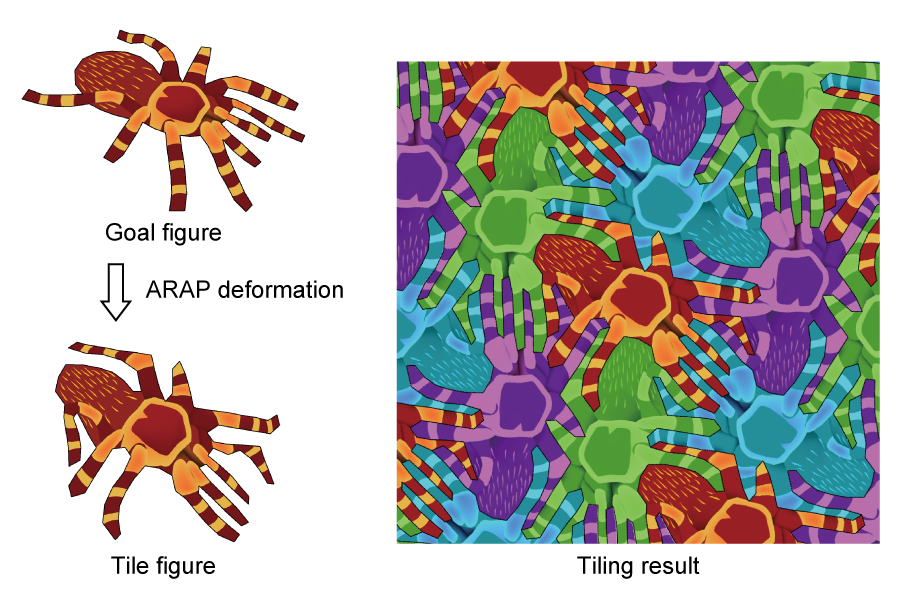This code is a C++ implementation of the algorithms developed in the following papers.
[1] Yuichi Nagata and Shinji Imahori, An Efficient Exhaustive Search Algorithm for the Escherization Problem, Algorithmica, Vol.82, No.9, 2502-2534, 2020. [link]
[2] Yuichi Nagata and Shinji Imahori, Escherization with Large Deformations Based on As-Rigid-As-Possible Shape Modeling, ACM Transactions on Graphics, Vol.41, No.2:11, 1-16, 2022. [link]
The following algorithms are implemented.
- EST with the Euclidean or AD distance
- EST with the E_I or E_IR distance
- Heuristic search with the E_I or E_IR distance
The author ran the programs on Ubuntu 16.04 and 20.04, where the following preparations may be required to compile the source code.
- Make the Eigen library (https://eigen.tuxfamily.org) available on your PC.
- Install the X11 library on your PC.
$ sudo apt install libx11-dev
Directory Data contains some goal figure files, which are divided into two types.
- Polygonal type: e.g. pegasus_60.dat
- Mesh type: e.g. pegasus_60_27.dat
See document.txt in directory Data for the data format.
It is recommended to run EST with the Euclidean distance first because this is the most basic one.
Before compiling the program, rewrite parts of the program directly.
- Set EST in line 10 of env_E.h.
- Set E or AD in line 10 of search_E_EST.h, depending on whether the Euclidean or AD distance is used.
Compile:
$ ./build_E.exe
$ mv jikken jikken_E
Then, a executable file jikken_E is created.
Execution:
$ ./jikken_E <string1> <string2> <integer1> <integer2>
<string1> : file name of a goal figure (polygonal type)
<string2> : file name to which results are written
<integer1> : results are displayed? 0:no, 1:yes
<integer2> : the number of top solutions stored
(Example)
$ ./jikken_E pegasus_60.dat ABC 1 20
Result:
The specified number of top solutions are saved in a file (ABC.tile in this example) and are displayed in the terminal, as shown in the example below
order = 0 eval=18994.244366: IH= 6 (18 4 18 7 4 3 ) 22
order = 1 eval=21028.815657: IH= 6 (5 14 5 12 14 4 ) 48
order = 2 eval=21868.573515: IH= 4 (13 4 7 13 14 3 ) 20
....
Each line represent the following values:
- order: ranking of the solution
- eval : the distance value
- IH : Isohedral type
- (...) : the numbers of points assigned to the tiling edges of the template
- right-most number : the value of
If <integer1> = 1, the top solutions (tile figures) are displayed. Press the return key to display the next solution.
The top solutions stored in a file can also be displayed (see "Display Result").
The solutions saved in a file (e.g. ABC.tile) can be displayed using this program.
Compile:
./build_display.exe
Then, the executable file "display.exe" is created.
Execution:
$ ./display.exe <string1>
<string1> : file name of a result file
Press the return key to display the next solution.
Before compiling the program, rewrite parts of the program directly.
- Set EST in line 10 of env_I.h.
- Set I or IR in line 10 of search_I_EST.h, depending on whether the E_I or E_IR distance is used.
Compile:
$ ./build_I.exe
$ mv jikken jikken_I
Then, a executable file jikken_I is created.
Execution:
$ ./jikken_I <string1> <string2> <integer1> <integer2> <double1>
<string1> : file name of a goal figure (mesh type)
<string2> : file name to which results are written
<integer1> : results are displayed? 0:no, 1:yes
<integer2> : the number of top solutions stored
<double1> : the value of
(Example)
$ ./jikken_I pegasus_60_27.dat ABC 1 20 0.5
Result:
Same as EST with the Euclidean distance.
Step 1: Obtaining promising configurations
Before compiling the program, rewrite a part of the program directly.
- Set CONF in line 10 of env_E.h.
Compile:
$ ./build_E.exe
$ mv jikken jikken_get_conf
Then, a executable file jikken_get_conf is created.
Execution:
$ ./jikken_get_conf <string1> <string2> <integer1> <integer2>
<string1> : file name of a goal figure (polygonal type)
<string2> : file name to which results are written
<integer1> : set 0 or 1 (a parameter not used)
<integer2> : the number of top configurations stored (10000-50000 is recommended)
(Example)
$ ./jikken_get_conf pegasus_60.dat ABC 0 50000
Then, the specified number of promising configurations are saved in a file (ABC.conf in this example).
Step 2: Perform optimization for the specified configurations
Before compiling the program, rewrite parts of the program directly.
- Set CONF in line 4 of env_I.h.
- Set I or IR in line 4 of search_I_EST.h, depending on whether the E_I or E_IR distance is used.
Compile:
$ ./build_I.exe
$ mv jikken jikken_I_conf
Then, a executable file jikken_I_conf is created.
Execution:
$ ./jikken_I_conf <string1> <string2> <integer1> <integer2> <double1> <string3>
<string1> : file name of a goal figure (mesh type)
<string2> : file name to which results are written
<integer1> : results are displayed? 0:no, 1:yes
<integer2> : the number of top solutions stored
<double1> : the value of
<string3> : file name of a promising configuration data
(Example)
$ ./jikken_I_conf pegasus_60_27.dat ABC 1 20 0.5 ABC.conf
Result:
Same as EST with the Euclidean distance.
